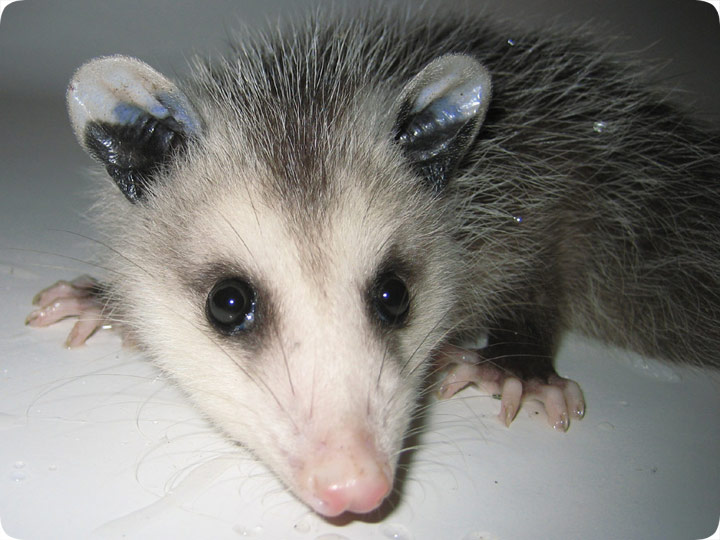-
info@aaanimalcontrol.com
Call us for help in your town
Humane Wildlife Education
Cute Baby Wildlife

07.02.2008 - Although I specialize in wildlife removal, I also like to take photographs of the critters from time to time. I really enjoy the baby wildlife. Kind of like how most people enjoy puppies and kittens. It's hard not to like these cute little guys.
Many people think that the adult opossum is an ugly animal. However, the baby is downright adorable. Just look at those little hands, that pink nose, those little
ears and those big brown eyes! I could just eat this little fellow right up! I also like the blue patches in the ears.
It's generally accepted that all
animals have a paternal response to juvenile features. It's a subtle study as to what makes something cute or not, but it's almost universally recognizable. All
animals and people seem to be able to recognize cuteness, and have a desire to care for it. After all, these baby animals can't fend for themselves very well, so their
strategy is to look cute and get taken care of. Even little opossums.
I have gathered several photos of cute baby animals, categorized by type, in the below three
albums. Take a look if you want to see more photos of cute baby wildlife.
Cute Baby Opossums
Cute Baby Raccoons
Cute Baby Squirrels
The opossum, (Didelphis virginiana) is a nocturnal animal that lives in North America. It is a marsupial, which means that the females give birth to tiny young, who grow in a pouch. These young eventually cling to the mother's back and drop off when they are large enough.
Opossums are unique for many reasons. They have opposable thumbs, prehensile tails, 50 teeth, and several other unusual features. They are omnivores who eat almost anything, they have excellent immune systems, and they rarely live more than 2-3 years in the wild. They are most
commonly considered a nuisance species when they live in an attic or other structure, such as under a shed, or steal pet food or threaten animals.
Do it yourself: Visit my How To Get Rid of Opossums page for tips and advice.
Get professional help: Visit my Nationwide Pro Directory of wildlife removal experts.
For more wildlife stories, click my Wildlife Blog
or click my below banner to hire a local trapper.
As the warmer weather approaches it is very common to encounter cute little baby wildlife on your property. This is a quite common scenario and needs to be tackled with patience and care. Expect a meeting with cute tiny creatures like baby birds, squirrels, raccoons, foxes, opossums, and skunks. As much as you would like to rescue them, you must know they are not always vulnerable and might be casually having a stroll in your backyard. You must not bother them unless you see some obvious signs.
Obvious Signs That the Animal Needs Help
If you are new to these encounters and don't want to hurt the animal, watch out for these signs in your little guests. If any of the listed signs exist, you should help them:
- The animal is bleeding.
- The animal shows signs of a broken limb.
- If your pet cat or dog has brought the animal to you.
- The animal sounds to be in pain.
- The animal is crying or wailing.
- The animal is wandering here and there seeming clueless of its surroundings.
- The animal is shivering (could be from fear or hunger)
The bird you found is featherless or has a few feathers, indicating that it is only a few days or weeks old. In some cases, you can help the animal yourself by reuniting them with their parents, feeding them, giving them first aid, or providing them shelter for the night. But if the situation seems out of hand you must contact a wildlife removal professional. It is often difficult to understand signs the animals give off.
How can you help a baby wild animal?
Here, we have discussed some typical baby wildlife behaviors and some tips to deal with them:
Baby Squirrels:
If the baby squirrel looks grown up and is independently running and hopping around, you don't need to intervene.
You must help the squirrel if: It has fallen off its nest.
It is trying to get near to humans or following them.
If its nest has fallen off the tree.
If the baby is too small for the chilly weather outside.
Here is what you can do:
Put it back in the nest and wait for the mother to come. Put it in a warm place outside and wait for the mother. Do not try to feed the baby. Call a wildlife professional if it is still outside and the mother doesn't return.
Baby Raccoons:
Mother raccoons are very caring towards their babies, so if you don't find a baby raccoon with its mother, observe it for a few hours to wait for the mother as she can't be away for too long. Contact wildlife professionals if the mother doesn't return.
Baby Opossums:
Baby opossums might fall off of their mother's back without her noticing them and hence you might encounter one lonely baby opossum in your yard. It is often difficult for people to distinguish between an opossum in need and one who is independent. The reason is their small size. When they come out of the mother opossum's pouch after two months, they will be a few inches long and ride on their mother's back. A general rule of thumb is if they are around seven inches they don't need your help.




















